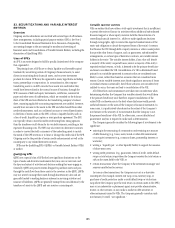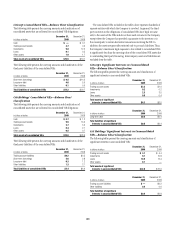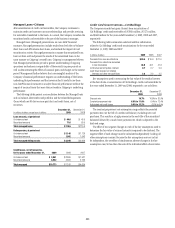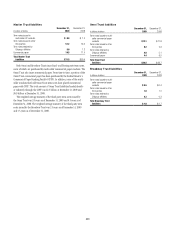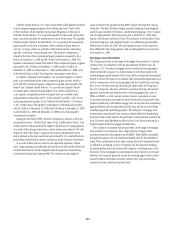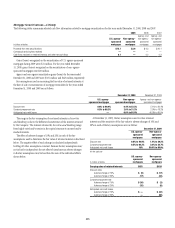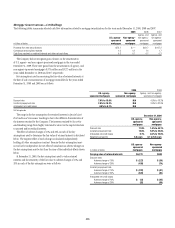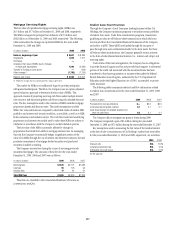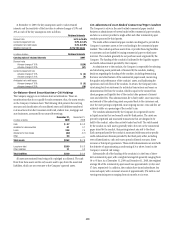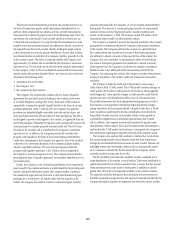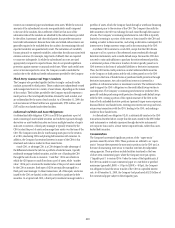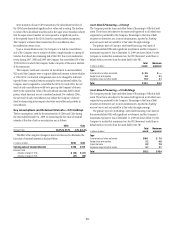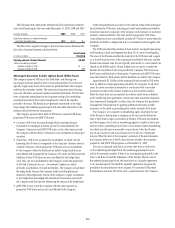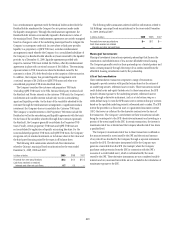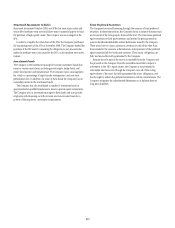Citibank 2009 Annual Report Download - page 214
Download and view the complete annual report
Please find page 214 of the 2009 Citibank annual report below. You can navigate through the pages in the report by either clicking on the pages listed below, or by using the keyword search tool below to find specific information within the annual report.204
Citibank (South Dakota), N.A. is the sole provider of full liquidity facilities
to the commercial paper programs of the Master and Omni Trusts. Both
of these facilities, which represent contractual obligations on the part of
Citibank (South Dakota), N.A. to provide liquidity for the issued commercial
paper, are made available on market terms to each of the trusts. The liquidity
facilities require Citibank (South Dakota), N.A. to purchase the commercial
paper issued by each trust at maturity, if the commercial paper does not
roll over, as long as there are available credit enhancements outstanding,
typically in the form of subordinated notes. The liquidity commitment
related to the Omni Trust commercial paper programs amounted to $4.4
billion at December 31, 2009 and $8.5 billion at December 31, 2008. The
liquidity commitment related to the Master Trust commercial paper program
amounted to $14.5 billion at December 31, 2009 and $11.0 billion at
December 31, 2008. As of December 31, 2009 and December 31, 2008, none
of the Master Trust or Omni Trust liquidity commitments were drawn.
In addition, Citibank (South Dakota), N.A. provides liquidity to a third-
party, non-consolidated multi-seller commercial paper conduit, which is
not a VIE. The commercial paper conduit has acquired notes issued by the
Omni Trust. Citibank (South Dakota), N.A. provides the liquidity facility
on market terms. Citibank (South Dakota), N.A. will be required to act
in its capacity as liquidity provider as long as there are available credit
enhancements outstanding and if: (1) the conduit is unable to roll over its
maturing commercial paper; or (2) Citibank (South Dakota), N.A. loses its
A-1/P-1 credit rating. The liquidity commitment to the third-party conduit
was $2.5 billion at December 31, 2009 and $3.6 billion at December 31, 2008.
As of December 31, 2009 and December 31, 2008, none of this liquidity
commitment was drawn.
During the first half of 2009, all three of Citigroup’s primary credit card
securitization trusts—Master Trust, Omni Trust, and Broadway Trust—had
bonds placed on ratings watch with negative implications by rating agencies.
As a result of the ratings watch status, certain actions were taken by Citi with
respect to each of the trusts. In general, the actions subordinated certain
senior interests in the trust assets that were retained by Citi, which effectively
placed these interests below investor interests in terms of priority of payment.
As a result of these actions, based on the applicable regulatory capital
rules, Citigroup began including the sold assets for all three of the credit card
securitization trusts in its risk-weighted assets for purposes of calculating
its risk-based capital ratios during 2009. The increase in risk-weighted
assets occurred in the quarter during 2009 in which the respective actions
took place. The effect of these changes increased Citigroup’s risk-weighted
assets by approximately $82 billion, and decreased Citigroup’s Tier 1 Capital
ratio by approximately 100 basis points each as of March 31, 2009, with
respect to the Master and Omni Trusts. The inclusion of the Broadway Trust
increased Citigroup’s risk-weighted assets by an additional approximately
$900 million at June 30, 2009. All bond ratings for each of the trusts have
been affirmed by the rating agencies, and no downgrades have occurred as
of December 31, 2009.
Mortgage Securitizations
The Company provides a wide range of mortgage loan products to a diverse
customer base. In connection with the securitization of these loans, the
Company’s U.S. Consumer mortgage business retains the servicing rights,
which entitles the Company to a future stream of cash flows based on the
outstanding principal balances of the loans and the contractual servicing fee.
Failure to service the loans in accordance with contractual requirements may
lead to a termination of the servicing rights and the loss of future servicing
fees. In non-recourse servicing, the principal credit risk to the Company is
the cost of temporary advances of funds. In recourse servicing, the servicer
agrees to share credit risk with the owner of the mortgage loans, such as
FNMA or FHLMC, or with a private investor, insurer or guarantor. Losses
on recourse servicing occur primarily when foreclosure sale proceeds of the
property underlying a defaulted mortgage loan are less than the outstanding
principal balance and accrued interest of the loan and the cost of holding
and disposing of the underlying property. The Company’s mortgage loan
securitizations are primarily non-recourse, thereby effectively transferring
the risk of future credit losses to the purchasers of the securities issued by the
trust. Securities and Banking and Special Asset Pool retain servicing for a
limited number of their mortgage securitizations.
The Company’s Consumer business provides a wide range of mortgage
loan products to its customers. Once originated, the Company often
securitizes these loans through the use of QSPEs. These QSPEs are funded
through the issuance of Trust Certificates backed solely by the transferred
assets. These certificates have the same average life as the transferred assets.
In addition to providing a source of liquidity and less expensive funding,
securitizing these assets also reduces the Company’s credit exposure to the
borrowers. These mortgage loan securitizations are primarily non-recourse.
However, the Company generally retains the servicing rights and in certain
instances retains investment securities, interest-only strips and residual
interests in future cash flows from the trusts.



